
|
|

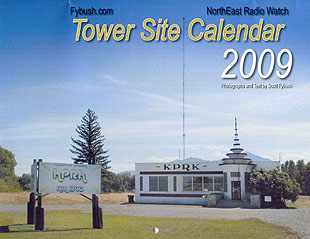 October 17, 2008
October 17, 2008
Two Buffalo AM/FM Sites
So we're all done with our recap of Big Trip 2007 - and just a few weeks ago, a big pile of boxes of Tower Site Calendar 2009 came back from the printer, all ready for sale and for your office or transmitter shack wall. We hope you'll take a moment to get your order in for the calendar, or better yet, show your support for Site of the Week and NorthEast Radio Watch with a subscription!
This week, we continue to look at some sites that aren't in the calendar, but are well worth a feature here on Site of the Week.
Over the last few weeks, we've looked at a bunch of sites to our east, in Syracuse and Utica. This week, we look an hour or so to the west, to Buffalo, as we profile a couple of sites that are easily seen from the highways that pass through the Queen City: the WEDG (103.3)/WWWS (1400) site that looms from a rocky outcropping above the interchange of the Kensington Expressway (NY 33) and the Scajaquada Expressway (NY 198), and the WHTT (104.1)/WBBF (1120) site that's easily seen just west of the Thruway (I-90) just north of its intersection with Ridge Road.
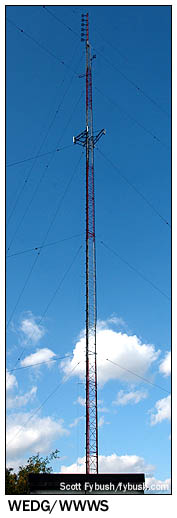
|
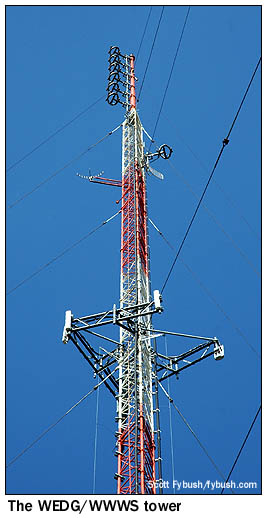
|
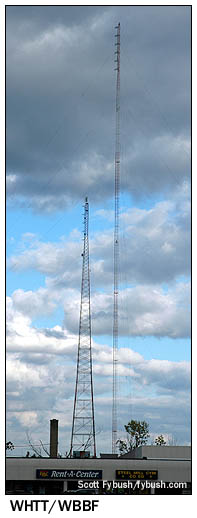
|
WEDG/WWWS first: What's now WWWS on 1400 can trace its routes back through two spots on the Buffalo AM dial. The license that's now on 1400 started its life back in 1934 as WBNY on 1370, sharing time with the Seneca Vocational School's WSVS and transmitting from a flat-top antenna on a building on Eagle Street. After World War II, WBNY moved to a tower on the Larkin Building, just east of downtown Buffalo, taking over the site that had been built for WEBR (1340) when that station moved to 970 from a new site down in Hamburg.
The second strand of history comes from a station up in Kenmore, on Niagara Falls Boulevard. WXRA (1080) signed on just after World War II, accompanied by an FM signal, WXRC (103.3). The stations became WINE and WINE-FM in the late fifties - and then in 1960 were sold to the legendary Gordon McLendon, creator of KLIF in Dallas and KABL in San Francisco.
McLendon wasted no time converting 1080 and 103.3 to beautiful music as WYSL and WYSL-FM, but he wanted a fulltime AM instead of the daytimer on 1080. So after not much more than a year, McLendon sold the 1080 signal (which became, and remains, Amherst-licensed WUFO) and bought WBNY, moving the WYSL calls to the fulltime 1400 signal from the Larkin Building. (Somewhere in this period, WYSL-FM moved from the 1080 tower to the Larkin Building tower as well.)
The WYSL simulcast split in the late sixties, with WYSL-FM experimenting with an early talk format and, for a time, teen DJs (including a few who'd go on to lengthy careers in the Buffalo market) before going progressive rock in 1970 as WPHD. The simulcast resumed again for a time in the early eighties, as 1400 became WPHD(AM), but then the stations went their separate ways again for good: 103.3 became classic rock "Fox" WUFX before taking its present WEDG calls and "Edge" modern rock format"; 1400 spent some time as oldies WGKT ("14KT Gold") and modern rock WXBX ("14X") before taking on a "Solid Gold Soul" R&B format and its present WWWS ("3WS") identity in 1993.
Today, WEDG is owned by Citadel Communications, while WWWS belongs to rival station group Entercom - but both share the little cinderblock building at the base of the tower (344 feet to the top of the pole that holds the six-bay antenna) that went up in 1978 to replace the old Larkin Building facility. There's a skirt that goes partway up the tower to create an antenna that's not quite half-wave for 1400, and some cellular antennas that were added later on just above the AM antenna.
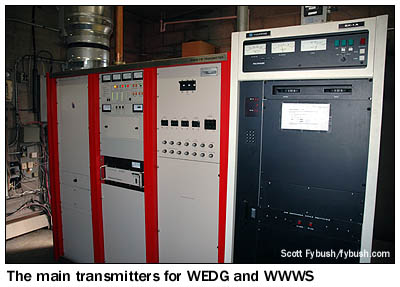
|
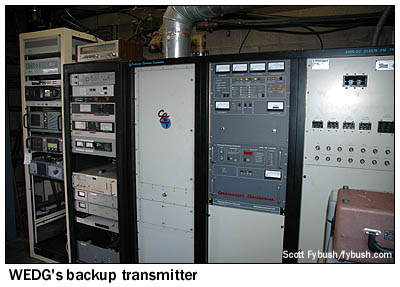
|
Inside the building, there's a mixture of history (an old Gates BC1T that serves as an aux for WWWS, long since supplanted by a Harris MW-1A as the station's main) and state-of-the-art (a brand new Continental 816HD that's the new main for WEDG, with the previous analog 816 relegated to backup duty), all tightly packed into the little box of a transmitter building tucked in down a hidden dirt path in a neighborhood that could charitably be called one of Buffalo's less scenic.
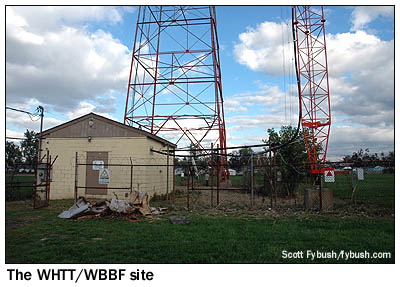
|

|
From WEDG and WWWS, we head south to an older site: Dorrance Park, behind a shopping mall in a working-class South Buffalo neighborhood, where the ball fields and dog walkers have some company: the two towers of Citadel's WBBF (1120) and its sister FM station, WHTT (104.1).
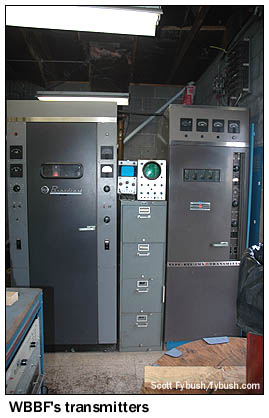 The
AM station signed on in 1947 as WWOL, a kilowatt daytimer licensed
to suburban Lackawanna, followed quickly by WWOL-FM on 104.1.
The stations were heavy on programming for Buffalo's large Polish
community in their early years; founding general manager Stan
Jasinski would go on to a long career in Buffalo broadcasting
that included ownership of two other stations, WMMJ (now WXRL)
and WUFO, as well as the founding of independent UHF station
WUTV (Channel 29).
The
AM station signed on in 1947 as WWOL, a kilowatt daytimer licensed
to suburban Lackawanna, followed quickly by WWOL-FM on 104.1.
The stations were heavy on programming for Buffalo's large Polish
community in their early years; founding general manager Stan
Jasinski would go on to a long career in Buffalo broadcasting
that included ownership of two other stations, WMMJ (now WXRL)
and WUFO, as well as the founding of independent UHF station
WUTV (Channel 29).
WWOL's studios were on Main Street in Lackawanna, with a transmitter in West Seneca; I'm not sure when the transmitter moved to the current location, but it looks like a pretty old tower.
In later years, WWOL and its sister FM station (which used the calls WWOR for a time, later to be made famous on TV in the New York market) pioneered country music in the Buffalo market, a niche later filled to even greater success by WYRK (106.5). The FM tried oldies for a few years in the early eighties as WACJ, followed by several years of simulcast top 40 on the AM and FM as WNYS and WNYS-FM.
In 1986, top 40 gave way to classic hits as the stations became WHTT/WHTT-FM, flipping to oldies a few years later. The AM exited the simulcast not long afterward, adding leased-time ethnic programming and eventually changing calls to WMNY (Mercury Broadcasting of New York), then in 2005 taking the WBBF calls that had been in use for so many decades just down the road in Rochester. (Payback for the WYSL calls landing on a Rochester-market AM two decades earlier, one supposes...)
Is that RCA BTA-1MX in the corner of the transmitter building original from 1947? That, I can't say for certain, but it's surely venerable, as is the BTA-1R1 next to it that remains WBBF's main transmitter to this day. (Well, at least to the day in the fall of 2007 when these pictures were taken...)
As for WHTT, its old RCA BTF-20E1 was in backup mode, next to the newer Continental 816R2C main transmitter (since supplanted, if I'm not mistaken, by an 816HD); out back, the original tower, a 322' self-supporter, is here just for backup now; the 1981-vintage replacement, a 502' guyed tower, serves as the main for both AM and FM.
- Previous Site of the Week: WTLB/WRCK/WKLL, Utica
- Next Week: WFIR, Roanoke, VA
- Site of the Week INDEX!
- How can you help support Site of the Week? Click here!
- Submit your suggestions for a future Site of the Week!
